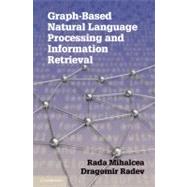
Note: Supplemental materials are not guaranteed with Rental or Used book purchases.
Purchase Benefits
Looking to rent a book? Rent Graph-based Natural Language Processing and Information Retrieval [ISBN: 9780521896139] for the semester, quarter, and short term or search our site for other textbooks by Rada Mihalcea , Dragomir Radev. Renting a textbook can save you up to 90% from the cost of buying.
| Introduction | p. 1 |
| Background | p. 3 |
| Book Organization | p. 4 |
| Acknowledgments | p. 7 |
| Introduction to Graph Theory | |
| Notations, Properties, and Representations | p. 11 |
| Graph Terminology and Notations | p. 11 |
| Graph Properties | p. 13 |
| Graph Types | p. 14 |
| Representing Graphs as Matrices | p. 15 |
| Using Matrices to Compute Graph Properties | p. 16 |
| Representing Graphs as Linked Lists | p. 17 |
| Eigenvalues and Eigenvectors | p. 18 |
| Graph-Based Algorithms | p. 20 |
| Depth-First Graph Traversal | p. 20 |
| Breadth-First Graph Traversal | p. 22 |
| Minimum Spanning Trees | p. 23 |
| Shortest-Path Algorithms | p. 26 |
| Cuts and Flows | p. 29 |
| Graph Matching | p. 31 |
| Dimensionality Reduction | p. 32 |
| Stochastic Processes on Graphs | p. 34 |
| Harmonic Functions | p. 38 |
| Random Walks | p. 40 |
| Spreading Activation | p. 41 |
| Electrical Interpretation of Random Walks | p. 42 |
| Power Method | p. 44 |
| Linear Algebra Methods for Computing Harmonic Functions | p. 45 |
| Method of Relaxations | p. 46 |
| Monte Carlo Methods | p. 47 |
| Networks | |
| Random Networks | p. 53 |
| Networks and Graphs | p. 53 |
| Random Graphs | p. 54 |
| Degree Distributions | p. 54 |
| Power Laws | p. 57 |
| Zipf's Law | p. 58 |
| Preferential Attachment | p. 61 |
| Giant Component | p. 62 |
| Clustering Coefficient | p. 62 |
| Small Worlds | p. 63 |
| Assortativity | p. 65 |
| Centrality | p. 67 |
| Degree Centrality | p. 67 |
| Closeness Centrality | p. 68 |
| Betweenness Centrality | p. 69 |
| Network Example | p. 70 |
| Dynamic Processes: Percolation | p. 72 |
| Strong and Weak Ties | p. 74 |
| Assortative Mixing | p. 76 |
| Structural Holes | p. 76 |
| Language Networks | p. 78 |
| Co-Occurrence Networks | p. 78 |
| Syntactic Dependency Networks | p. 80 |
| Semantic Networks | p. 81 |
| Similarity Networks | p. 85 |
| Graph-Based Information Retrieval | |
| Link Analysis for the World Wide Web | p. 91 |
| The Web as a Graph | p. 91 |
| PageRank | p. 92 |
| Undirected Graphs | p. 95 |
| Weighted Graphs | p. 95 |
| Combining PageRank with Content Analysis | p. 97 |
| Topic-Sensitive Link Analysis | p. 97 |
| Query-Dependent Link Analysis | p. 100 |
| Hyperlinked-Induced Topic Search | p. 101 |
| Document Reranking with Induced Links | p. 103 |
| Text Clustering | p. 106 |
| Graph-Based Clustering | p. 108 |
| Spectral Methods | p. 111 |
| The Fiedler Method | p. 113 |
| The Kernighan-Lin Method | p. 114 |
| Betweenness-Based Clustering | p. 115 |
| Min-Cut Clustering | p. 117 |
| Text Clustering Using Random Walks | p. 119 |
| Graph-Based Natural Language Processing | |
| Semantics | p. 123 |
| Semantic Classes | p. 123 |
| Synonym Detection | p. 125 |
| Semantic Distance | p. 126 |
| Textual Entailment | p. 129 |
| Word-Sense Disambiguation | p. 131 |
| Name Disambiguation | p. 134 |
| Sentiment and Subjectivity | p. 135 |
| Syntax | p. 140 |
| Part-of-Speech Tagging | p. 140 |
| Dependency Parsing | p. 141 |
| Prepositional-Phrase Attachment | p. 144 |
| Co-Reference Resolution | p. 146 |
| Applications | p. 149 |
| Summarization | p. 149 |
| Semi-supervised Passage Retrieval | p. 150 |
| Keyword Extraction | p. 154 |
| Topic Identification | p. 156 |
| Topic Segmentation | p. 161 |
| Discourse | p. 162 |
| Machine Translation | p. 165 |
| Cross-Language Information Retrieval | p. 166 |
| Information Extraction | p. 169 |
| Question Answering | p. 171 |
| Term Weighting | p. 174 |
| Bibliography | p. 179 |
| Index | p. 191 |
| Table of Contents provided by Ingram. All Rights Reserved. |
The New copy of this book will include any supplemental materials advertised. Please check the title of the book to determine if it should include any access cards, study guides, lab manuals, CDs, etc.
The Used, Rental and eBook copies of this book are not guaranteed to include any supplemental materials. Typically, only the book itself is included. This is true even if the title states it includes any access cards, study guides, lab manuals, CDs, etc.